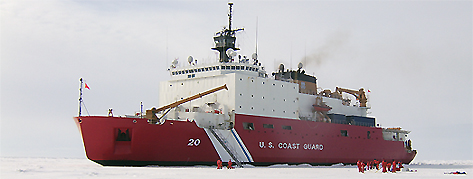 |
 |
 |
 |
 |
 |
Northern Bering and Chukchi Seas 2008
![]()
![]()
![]()
![]()
![]()
![]()
![]()
![]()
We will be involved in 3 cruises this year:
HLY0801 on board USCGC HEALY March 13-26, 2008
Canada's 3 Oceans on board Laurier July 2008
RUSALCA
HLY0801
Chief Scientist:
Lee W. Cooper
(lcooper1@utk.edu
or cooper@cbl.umces.edu), Chesapeake Biological Laboratory,
University of Maryland Center for Environmental Science
HLY0801Cruise
Plan
HLY0801 Station
close up pdf
One page
summary of cruise plan pdf
Patch dynamics is a
conceptual approach to ecosystem and habitat analysis that
emphasizes the dynamics of heterogeneity within a system.
Benthic-oriente d
measurements have been taken in the northern Bering Sea for many
years because the region is known to support highly productive
benthic communities and food resources for benthic-feeding apex
predators, including gray whales, bearded seals, walruses, and
diving sea-ducks—all of which are important for subsistence
hunting by local Bering Sea communities. Continued benthic
sampling is planned in the St. Lawrence Island area to complement
the planned field studies of walrus distributions. Recent
studies (e.g. Grebmeier et al. (2006;
Science 10
March 2006: Vol. 311. no. 5766, pp. 1461 - 1464)
suggested that climate warming may change the present
benthic-dominated northern Bering Sea ecosystem to one more
pelagic in nature, similar to the southern Bering Sea—a direct
result of changing trophic interactions. Specific
evaluation of dominant infaunal prey of walrus (e.g., bivalves,
gastropods, and polychaetes), will be undertaken during the
benthic field component of this BSIERP-BEST walrus-prey patch
dynamics study. We will plan to place these studies in the
context of retrospective benthic data sets collected over the
last 20 years in the region. We will be evaluating the spatial
heterogeneity of benthic infaunal population and sediment tracers
in oceanographic context at coarse scales (20 nm) to evaluate
overall effects on ecological processes. We will also strive to
develop scaling strategies and limitations for extrapolating
information from the small scale (3-5 nm) used for our
walrus-prey patch dynamics study to larger (10-20 nm) and even
regional (50-100 nm) scales in order to evaluate information from
the local ecosystem to overall northern Bering Sea regional scale
in which the walrus reside.
d
measurements have been taken in the northern Bering Sea for many
years because the region is known to support highly productive
benthic communities and food resources for benthic-feeding apex
predators, including gray whales, bearded seals, walruses, and
diving sea-ducks—all of which are important for subsistence
hunting by local Bering Sea communities. Continued benthic
sampling is planned in the St. Lawrence Island area to complement
the planned field studies of walrus distributions. Recent
studies (e.g. Grebmeier et al. (2006;
Science 10
March 2006: Vol. 311. no. 5766, pp. 1461 - 1464)
suggested that climate warming may change the present
benthic-dominated northern Bering Sea ecosystem to one more
pelagic in nature, similar to the southern Bering Sea—a direct
result of changing trophic interactions. Specific
evaluation of dominant infaunal prey of walrus (e.g., bivalves,
gastropods, and polychaetes), will be undertaken during the
benthic field component of this BSIERP-BEST walrus-prey patch
dynamics study. We will plan to place these studies in the
context of retrospective benthic data sets collected over the
last 20 years in the region. We will be evaluating the spatial
heterogeneity of benthic infaunal population and sediment tracers
in oceanographic context at coarse scales (20 nm) to evaluate
overall effects on ecological processes. We will also strive to
develop scaling strategies and limitations for extrapolating
information from the small scale (3-5 nm) used for our
walrus-prey patch dynamics study to larger (10-20 nm) and even
regional (50-100 nm) scales in order to evaluate information from
the local ecosystem to overall northern Bering Sea regional scale
in which the walrus reside.
Core Projects:
BEST
Benthic Ecosystem Response to Changing Ice Cover in the Bering
Sea
(National Science Foundation ARC-0802290),
Jackie Grebmeier and Lee Cooper, PIs
BSIERP: Patch Dynamics (North Pacific Research Board project O4.62), Andrew Trites and Chad Jay, lead shipboard PIs
Other Participating Projects:
BEST: Sea Ice Algae, a Major Food Source for Herbivorous Plankton
and Benthos in the Eastern Bering Sea (NSF ARC-0732767) PIs:
Rolf Gradinger, Bodil Bluhm, Katrin Iken
BSIERP Project: Epi-benthic survey (NPRB project) PIs: Jackie Grebmeier, Lee Cooper
Impacts of Sea Ice Variability and Polynya Formation on Biological Productivity in the Northern Bering Sea (NSF ARC-0713939) PI: Karen Frey
Climate-driven changes in impacts of benthic predators in the northern Bering Sea (NSF ARC-0454454) PIs: Jim Lovvorn, Jackie Grebmeier, Lee Cooper
North Pacific Pelagic Seabird Observer Program (NPRB Project 637) PIs: Kathy Kuletz, David Irons
Optics under sea ice and heat absorption impacted
by bioprocess (Chinese International Polar Year Program)
PI: Jinping Zhao, Ocean University of China
National Marine Mammal Laboratory shipboard marine mammal observation program PI: Sue Moore
Thin Ice: An Exploration of the Bering Sea at the Dawn of Global Warming A public education project for the International Polar Year- 2007-2008 PIs: Thomas Litwin and Larry Hott
![]()
|
This page last
updated by Kim Harmon and Lee Cooper Saturday March 08, 2008 Any questions please contact us. |
|
|
|
|